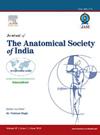Effect of different doses of aluminum chloride on neurodegeneration in hippocampus region of the rat brain
IF 0.2
4区 医学
Q4 ANATOMY & MORPHOLOGY
引用次数: 0
Abstract
Introduction: Aluminum (AL) compounds are widely used as food additives, cosmetics, antacids, and buffered aspirins. Chronic consumption of AL may lead to its accumulation in tissues causing AL toxicity. The study aims to investigate the toxic effect of AlCl3 on hippocampus region of rat brain by qualitative and quantitative analysis of neurons. Material and Methods: Adult male albino Wistar rats were divided into three groups with six rats in each group. Group 1 was the control, Group 2 rats received 100 mg/kg b. w, and Group 3 received 300 mg/kg b. w of AlCl3 orally for 30 days. The neuronal count was done at the CA1, CA2, CA3, and CA4 regions of hippocampus by staining with cresyl violet stain. Neuronal damage in the AlCl3 groups was compared with the control group. Results: A significant damage was observed in all the regions of hippocampus both in Groups 2 and 3 compared to the control group (P < 0.00001). Further higher dose of AL caused marked neuronal damage in CA1 (P < 0.03) and CA3 (P < 0.05) regions compared to the lower dose of AL. The neurons in the CA3 and CA1 regions were most vulnerable to AL toxicity and the CA2 region of the hippocampus had a maximum number of viable neurons indicative of resistance to AL toxicosis. Discussion and Conclusion: Consumption of higher dose of AL even for a short term could have variable degrees of deleterious effects on different regions of the rat brain. This study sets a background for an in-depth exploration on toxicology of AL compounds on human participants which could be of public health importance.不同剂量氯化铝对大鼠脑海马区神经退行性变的影响
铝(AL)化合物广泛用于食品添加剂、化妆品、抗酸剂和缓冲阿司匹林。慢性消耗AL可导致其在组织中积累,引起AL毒性。本研究旨在通过神经元的定性和定量分析,探讨AlCl3对大鼠脑海马区的毒性作用。材料与方法:将成年雄性白化Wistar大鼠分为3组,每组6只。1组为对照组,2组给予AlCl3 100 mg/kg b. w, 3组给予AlCl3 300 mg/kg b. w,连续30 d。用甲酚紫染色法对海马CA1、CA2、CA3、CA4区进行神经元计数。比较AlCl3组与对照组的神经元损伤情况。结果:与对照组相比,2、3组海马各区域均出现明显损伤(P < 0.00001)。与低剂量AL相比,高剂量AL在CA1区和CA3区造成了明显的神经元损伤(P < 0.03), CA3和CA1区的神经元对AL毒性最敏感,海马CA2区存活神经元数量最多,表明对AL毒性有抗性。讨论与结论:即使短期服用高剂量的AL,也会对大鼠大脑的不同区域产生不同程度的有害影响。本研究为深入探索AL化合物对人类参与者的毒理学奠定了基础,这可能对公共卫生具有重要意义。
本文章由计算机程序翻译,如有差异,请以英文原文为准。
求助全文
约1分钟内获得全文
求助全文
来源期刊

Journal of the Anatomical Society of India
ANATOMY & MORPHOLOGY-
CiteScore
0.40
自引率
25.00%
发文量
15
审稿时长
>12 weeks
期刊介绍:
Journal of the Anatomical Society of India (JASI) is the official peer-reviewed journal of the Anatomical Society of India.
The aim of the journal is to enhance and upgrade the research work in the field of anatomy and allied clinical subjects. It provides an integrative forum for anatomists across the globe to exchange their knowledge and views. It also helps to promote communication among fellow academicians and researchers worldwide. It provides an opportunity to academicians to disseminate their knowledge that is directly relevant to all domains of health sciences. It covers content on Gross Anatomy, Neuroanatomy, Imaging Anatomy, Developmental Anatomy, Histology, Clinical Anatomy, Medical Education, Morphology, and Genetics.
 求助内容:
求助内容: 应助结果提醒方式:
应助结果提醒方式:


